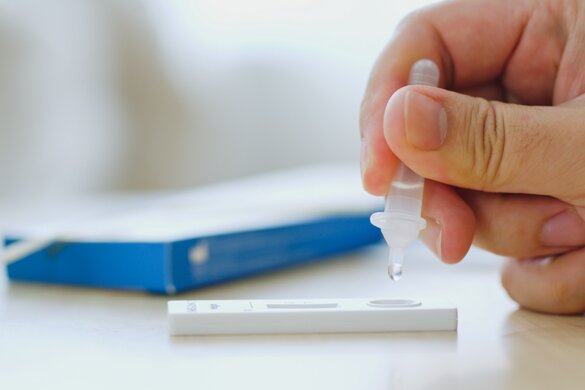Lateral Flow Assay Tests for Detecting Drugs of Abuse
Drug molecules are small and if directly striped on a membrane, they would “sink” into the sponge-like matrix of the nitrocellulose membrane. Consequently, drug molecules are conjugated to a carrier protein such as Bovine Serum Albumin (BSA) (most common), Bovine thyroglobulin (BTG), and even ovalbumin. The carrier protein part of the conjugate binds to the membrane and exposes the drug for the antibodies to “find”. In most drug tests, the drug BSA conjugate will be on the capture or test line and the antibody to that drug or its metabolites is bound to a detector particle such as gold nanoparticles or colored latex beads.
The drug conjugate and the corresponding antibody are sold as a carefully matched pair. There are matched pairs for detection of the native or parent drug, and there are matched pairs for detection of the metabolite of the drug which is the excreted product of the drug after it passes through the liver and into the kidney. Thus, metabolites are generally detected in urine or blood, and parent drugs are found in saliva. However, saliva does have enzymes that metabolize certain drugs, so in some cases, the reagents for the drug metabolite may be used in a saliva test.

Most common drugs of abuse are assigned cutoff values. Some illegal drugs such as morphine have several cutoff values. This is because some drug reagents may cross-react with innocuous substances which are legally consumed.
A good example is a morphine test which can give a positive result for an individual who may have eaten poppy seeds or the prescribed dose of a cough syrup. The low cutoff for morphine is set above the number of poppy seeds a person would normally consume. Often a disclaimer may be written into the test procedure. Some of the newer designer drugs of abuse have no established cutoff values.
Examples of cutoff values for common drug tests for urine samples
- Amphetamine – 1000 ng/ml, 500 ng/ml
- Barbital – 300 ng/ml
- Benzodiazepine – 300 ng/ml, 100 ng/ml
- Buprenorphine – 10 ng/ml
- Cocaine/Benzoylecgonine metabolite – 300 ng/ml
- Fentanyl – 10 ng/ml
- K2 (Spice) – 50 ng/ml
- Ketamine – 100 ng/ml, 300 ng/ml, 1000 ng/ml
- MDMA – 500 ng/ml, 1000 ng/ml
- Methadone – 300 ng/ml
- Methamphetamine – 1000 ng/ml, 500 ng/ml
- Morphine/Opiates – 300 ng/ml and 2000 ng/ml
- Oxycodone – 100 ng/ml
- Phencyclidine (PCP) – 25 ng/ml
- Propoxyphene – 300 ng/ml
- THC urine metabolite – 50 ng/ml
- Tricyclic Antidepressants (TCA) – 1000 ng/ml
Drug tests are competition assays. The drug BSA conjugate is dispensed on the test line. The antibody to the drug is conjugated to a detector particle such as gold nanoparticle. If the urine or saliva sample is negative for the drug, the sample will wash the gold conjugated antibody up the membrane and over the test line where the antibody will bind to its drug and form a visible test line. If the urine or saliva sample contains the drug or drug metabolite, the sample containing drug will meet up with the antibody-gold conjugate, which binds up the free drug before the sample/gold conjugate migrates up to the test line, leaving little or no antibody-gold conjugate to bind to the drug on the test line. The result is a weak test line or no line at all. So, the free drug and the bound drug are in competition for the antibody on the detector particle. A good drug test will produce a line of strong or weak intensity below the official cutoff (-50% cutoff), with absence of test line at the cutoff or cutoff +50%.
Antibodies for the competition assays are evaluated for their ability to bind to the drug BSA (bound drug) on the membrane and to bind to the free drug (unbound) in the sample. This must happen at the appropriate cut-off value for the drug. The antibody must have the required displacement curve. If the curve is too flat, the test line will persist beyond the desired cutoff value. If the curve is too sharp, the actual cutoff will be short of the desired cutoff and will possibly penalize a person as being positive for the drug when in fact they are below the cutoff (as in an individual who eats poppy seeds). The process of antibody development is a careful balance between the binding to the test line and the free drug in the sample.
Competition assays are applicable to any detection system targeting a small molecule. Therapeutic drugs, pesticides, herbicides or other environmental chemical contaminants would fall under this category. Feasibility studies for competition assays, must determine the displacement curve of the antibody, i.e. whether it can produce a sufficiently intense negative signal with very faint or no signal at the desired cutoff or detection level.
By their very nature, competition assays are semi-quantitative. They are usually designed for visible evaluation by the end user. A negative sample will produce a test line, an appropriately positive sample will not produce a test line. In between those analyte values, there may be various degrees of test line which cannot be visually quantified. If a more absolute answer is desirable, the use of a reader may be helpful.
Antibodies for Detecting Drugs of Abuse